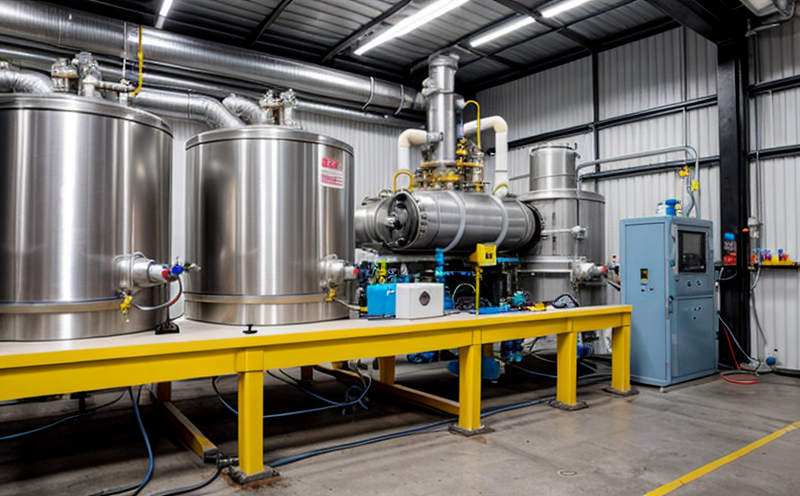ISO 8529-2 Reference Neutron Radiation for Flux Measurement
The ISO 8529-2 standard provides a robust framework for generating reference neutron radiation used in flux measurement. This method ensures accuracy and consistency across different testing environments, which is crucial in industries like nuclear power generation, material science, and environmental monitoring.
ISO 8529-2 specifies the procedures to generate and characterize reference neutron fields that can be used as a benchmark for calibrating neutron flux measurement systems. The standard covers the production of a monoenergetic or broad-spectrum neutron field with well-characterized energy spectra, ensuring reliability in various applications.
The process involves several critical steps, including the selection of appropriate materials and sources to generate neutrons at specific energies, followed by detailed characterization using advanced detectors and software. This ensures that the generated radiation meets stringent criteria set forth by ISO 8529-2.
Compliance with this standard is essential for ensuring accurate measurement and calibration in neutron flux applications. It helps minimize errors and inconsistencies that can arise from non-standardized testing methods, thereby enhancing overall quality control processes.
The use of reference neutron radiation generated according to ISO 8529-2 ensures consistent performance across different measurement systems and environments. This standardization is particularly important for industries where precision in neutron flux measurements is paramount, such as nuclear reactor design and operation, material irradiation studies, and environmental monitoring.
By adhering to the procedures outlined in ISO 8529-2, laboratories can provide reliable reference radiation that serves as a benchmark for calibration purposes. This not only enhances accuracy but also fosters trust among stakeholders involved in neutron flux measurement activities.
Why It Matters
The importance of accurate and consistent neutron flux measurements cannot be overstated, especially in high-stakes applications such as nuclear power generation and medical isotope production. ISO 8529-2 provides a standardized approach to generating reference neutron radiation, which directly impacts the reliability and accuracy of these critical processes.
In nuclear power plants, precise control over neutron flux is essential for optimizing reactor performance and ensuring safety. Any deviation in neutron flux measurements could lead to operational inefficiencies or even safety hazards. By using ISO 8529-2 compliant reference radiation, power plant operators can ensure that their measurement systems are calibrated accurately, leading to more reliable operations.
Similarly, in the medical isotopes sector, accurate neutron flux calibration is vital for producing isotopes used in diagnostic and therapeutic applications. Any inconsistency in neutron flux measurements could affect the quality of the isotopes produced, potentially impacting patient outcomes. ISO 8529-2 compliant reference radiation helps maintain consistency across different production facilities, ensuring that the isotopes meet stringent quality standards.
The use of standard reference neutron radiation also benefits research and development efforts by providing a common benchmark for comparing results from various laboratories and institutions. This enhances collaboration and facilitates the sharing of knowledge within the scientific community.
Moreover, compliance with ISO 8529-2 can help organizations meet regulatory requirements, thereby reducing the risk of non-compliance penalties and improving their reputation among clients and stakeholders.
Competitive Advantage and Market Impact
- Enhanced Reliability: By adhering to ISO 8529-2, laboratories can ensure that the neutron radiation used in flux measurement is of high quality and consistent across different environments.
- Increased Accuracy: Standardized reference radiation improves the accuracy of flux measurements, leading to more reliable results and better decision-making.
- Better Calibration: The use of ISO 8529-2 compliant reference radiation ensures that calibration processes are accurate and consistent, reducing errors in measurement systems.
- Increased Trust: Compliance with international standards like ISO 8529-2 enhances the trustworthiness of laboratory results, which is crucial for maintaining client relationships.
- Regulatory Compliance: Adherence to this standard helps organizations meet regulatory requirements, thereby reducing the risk of non-compliance penalties.
- Improved Reputation: By demonstrating commitment to quality and accuracy through adherence to ISO 8529-2, laboratories can enhance their reputation among clients and stakeholders.
The ability to produce accurate and consistent reference neutron radiation according to ISO 8529-2 provides a significant competitive advantage in the market. It allows laboratories to offer high-quality services that meet stringent international standards, thereby attracting more business from discerning clients who value accuracy and reliability.
Use Cases and Application Examples
The application of ISO 8529-2 reference neutron radiation extends across various industries and applications, each requiring precise flux measurements for optimal performance. Here are some key use cases:
- Nuclear Power Generation: Accurate neutron flux measurement is crucial for optimizing reactor operations and ensuring safety.
- Material Science: Neutron activation analysis using ISO 8529-2 compliant radiation helps in understanding material properties under specific neutron fluence conditions.
- Mining Industry: Calibration of neutron detectors used in ore processing plants ensures accurate measurement of neutron flux, impacting efficiency and safety.
- Medical Isotopes Production: Precise neutron flux calibration is essential for producing isotopes used in diagnostic and therapeutic applications.
- Radiation Therapy: Neutron radiation generated according to ISO 8529-2 standards helps in optimizing treatment plans, ensuring patient safety and efficacy.
In each of these applications, the use of high-quality reference neutron radiation ensures that measurements are accurate and consistent, leading to better outcomes. For instance, in nuclear power generation, accurate flux measurement can lead to optimized fuel utilization and extended reactor life. In medical isotopes production, precise calibration helps ensure the quality and safety of the isotopes produced.





